Public Services Health & Safety Management: Legislation Report
VerifiedAdded on 2024/05/21
|9
|2546
|129
Report
AI Summary
This report provides an overview of health and safety management within public services, with a focus on the importance of key legislation such as HASAWA 1974, RIDDOR, PPE, and ACOP. It highlights the responsibilities of employers and employees in maintaining a safe working environment, including the prevention, reporting, and investigation of incidents, accidents, and injuries. The report emphasizes the need for effective management strategies to mitigate risks and ensure the well-being of workers in the public services sector, particularly within organizations like Mitie, a UK-based construction company. It also discusses the legal obligations and preventive measures necessary for business sustainability and adherence to health and safety standards. Desklib provides a platform to access this and similar solved assignments.
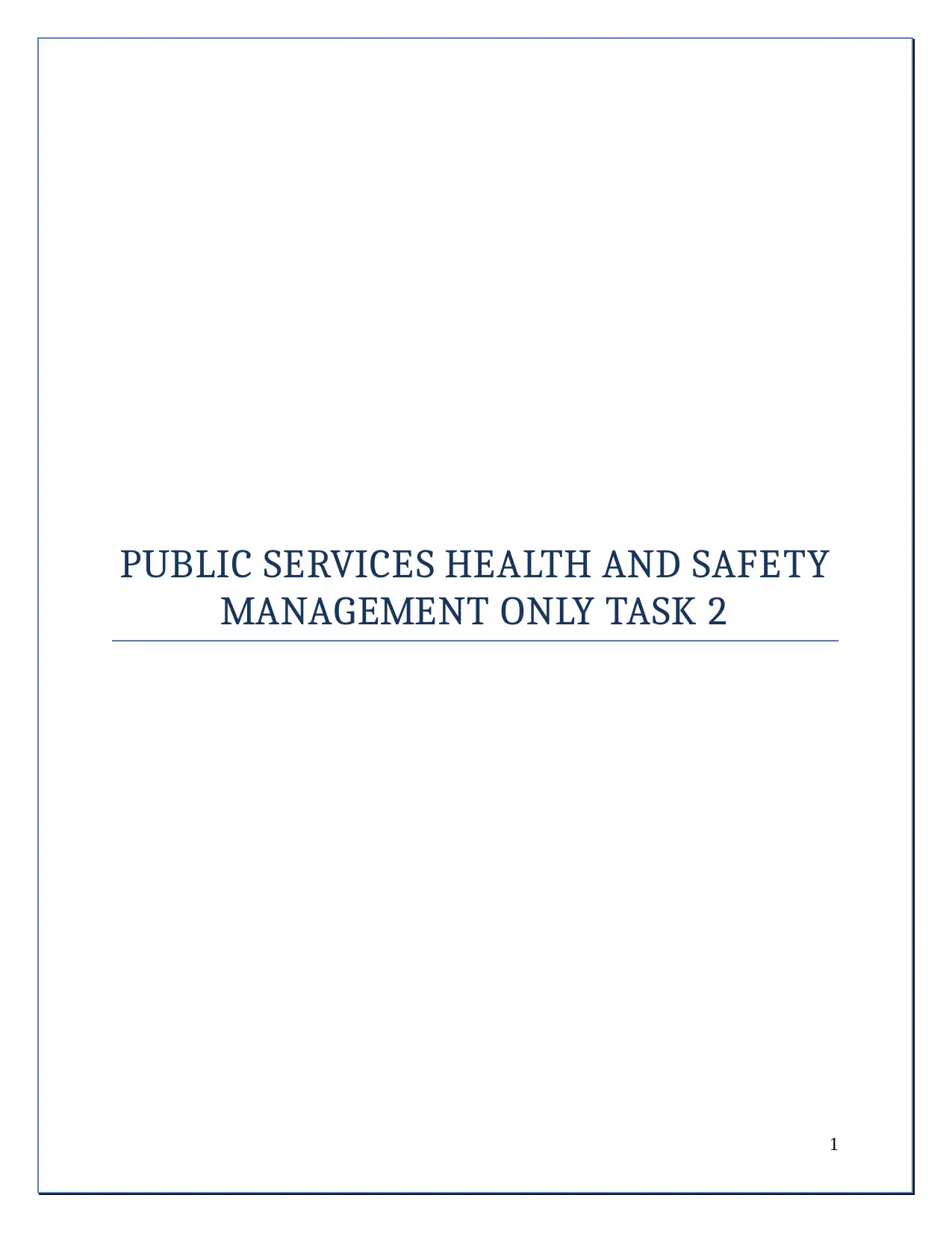
PUBLIC SERVICES HEALTH AND SAFETY
MANAGEMENT ONLY TASK 2
1
MANAGEMENT ONLY TASK 2
1
Paraphrase This Document
Need a fresh take? Get an instant paraphrase of this document with our AI Paraphraser
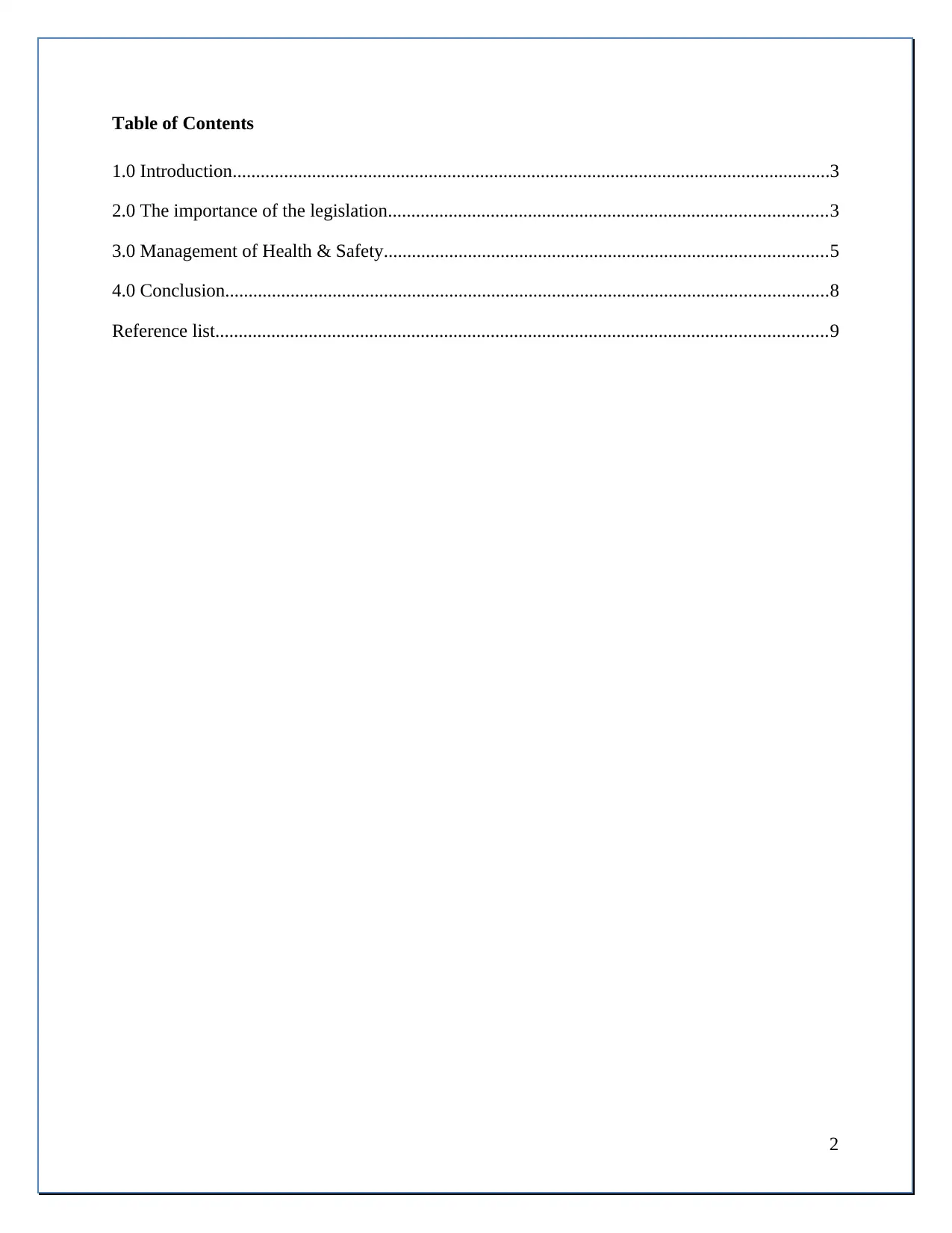
Table of Contents
1.0 Introduction................................................................................................................................3
2.0 The importance of the legislation..............................................................................................3
3.0 Management of Health & Safety...............................................................................................5
4.0 Conclusion.................................................................................................................................8
Reference list...................................................................................................................................9
2
1.0 Introduction................................................................................................................................3
2.0 The importance of the legislation..............................................................................................3
3.0 Management of Health & Safety...............................................................................................5
4.0 Conclusion.................................................................................................................................8
Reference list...................................................................................................................................9
2
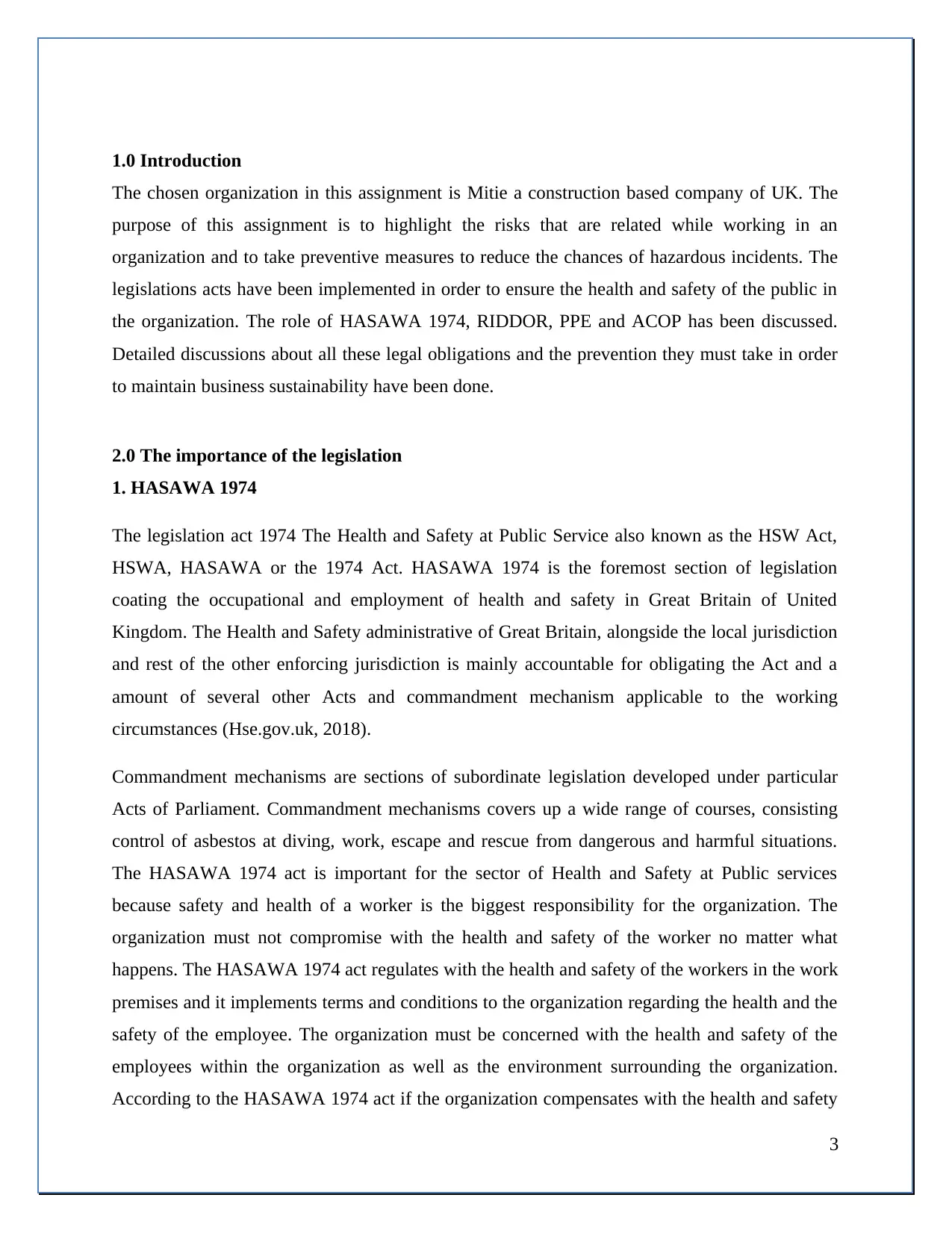
1.0 Introduction
The chosen organization in this assignment is Mitie a construction based company of UK. The
purpose of this assignment is to highlight the risks that are related while working in an
organization and to take preventive measures to reduce the chances of hazardous incidents. The
legislations acts have been implemented in order to ensure the health and safety of the public in
the organization. The role of HASAWA 1974, RIDDOR, PPE and ACOP has been discussed.
Detailed discussions about all these legal obligations and the prevention they must take in order
to maintain business sustainability have been done.
2.0 The importance of the legislation
1. HASAWA 1974
The legislation act 1974 The Health and Safety at Public Service also known as the HSW Act,
HSWA, HASAWA or the 1974 Act. HASAWA 1974 is the foremost section of legislation
coating the occupational and employment of health and safety in Great Britain of United
Kingdom. The Health and Safety administrative of Great Britain, alongside the local jurisdiction
and rest of the other enforcing jurisdiction is mainly accountable for obligating the Act and a
amount of several other Acts and commandment mechanism applicable to the working
circumstances (Hse.gov.uk, 2018).
Commandment mechanisms are sections of subordinate legislation developed under particular
Acts of Parliament. Commandment mechanisms covers up a wide range of courses, consisting
control of asbestos at diving, work, escape and rescue from dangerous and harmful situations.
The HASAWA 1974 act is important for the sector of Health and Safety at Public services
because safety and health of a worker is the biggest responsibility for the organization. The
organization must not compromise with the health and safety of the worker no matter what
happens. The HASAWA 1974 act regulates with the health and safety of the workers in the work
premises and it implements terms and conditions to the organization regarding the health and the
safety of the employee. The organization must be concerned with the health and safety of the
employees within the organization as well as the environment surrounding the organization.
According to the HASAWA 1974 act if the organization compensates with the health and safety
3
The chosen organization in this assignment is Mitie a construction based company of UK. The
purpose of this assignment is to highlight the risks that are related while working in an
organization and to take preventive measures to reduce the chances of hazardous incidents. The
legislations acts have been implemented in order to ensure the health and safety of the public in
the organization. The role of HASAWA 1974, RIDDOR, PPE and ACOP has been discussed.
Detailed discussions about all these legal obligations and the prevention they must take in order
to maintain business sustainability have been done.
2.0 The importance of the legislation
1. HASAWA 1974
The legislation act 1974 The Health and Safety at Public Service also known as the HSW Act,
HSWA, HASAWA or the 1974 Act. HASAWA 1974 is the foremost section of legislation
coating the occupational and employment of health and safety in Great Britain of United
Kingdom. The Health and Safety administrative of Great Britain, alongside the local jurisdiction
and rest of the other enforcing jurisdiction is mainly accountable for obligating the Act and a
amount of several other Acts and commandment mechanism applicable to the working
circumstances (Hse.gov.uk, 2018).
Commandment mechanisms are sections of subordinate legislation developed under particular
Acts of Parliament. Commandment mechanisms covers up a wide range of courses, consisting
control of asbestos at diving, work, escape and rescue from dangerous and harmful situations.
The HASAWA 1974 act is important for the sector of Health and Safety at Public services
because safety and health of a worker is the biggest responsibility for the organization. The
organization must not compromise with the health and safety of the worker no matter what
happens. The HASAWA 1974 act regulates with the health and safety of the workers in the work
premises and it implements terms and conditions to the organization regarding the health and the
safety of the employee. The organization must be concerned with the health and safety of the
employees within the organization as well as the environment surrounding the organization.
According to the HASAWA 1974 act if the organization compensates with the health and safety
3
⊘ This is a preview!⊘
Do you want full access?
Subscribe today to unlock all pages.

Trusted by 1+ million students worldwide
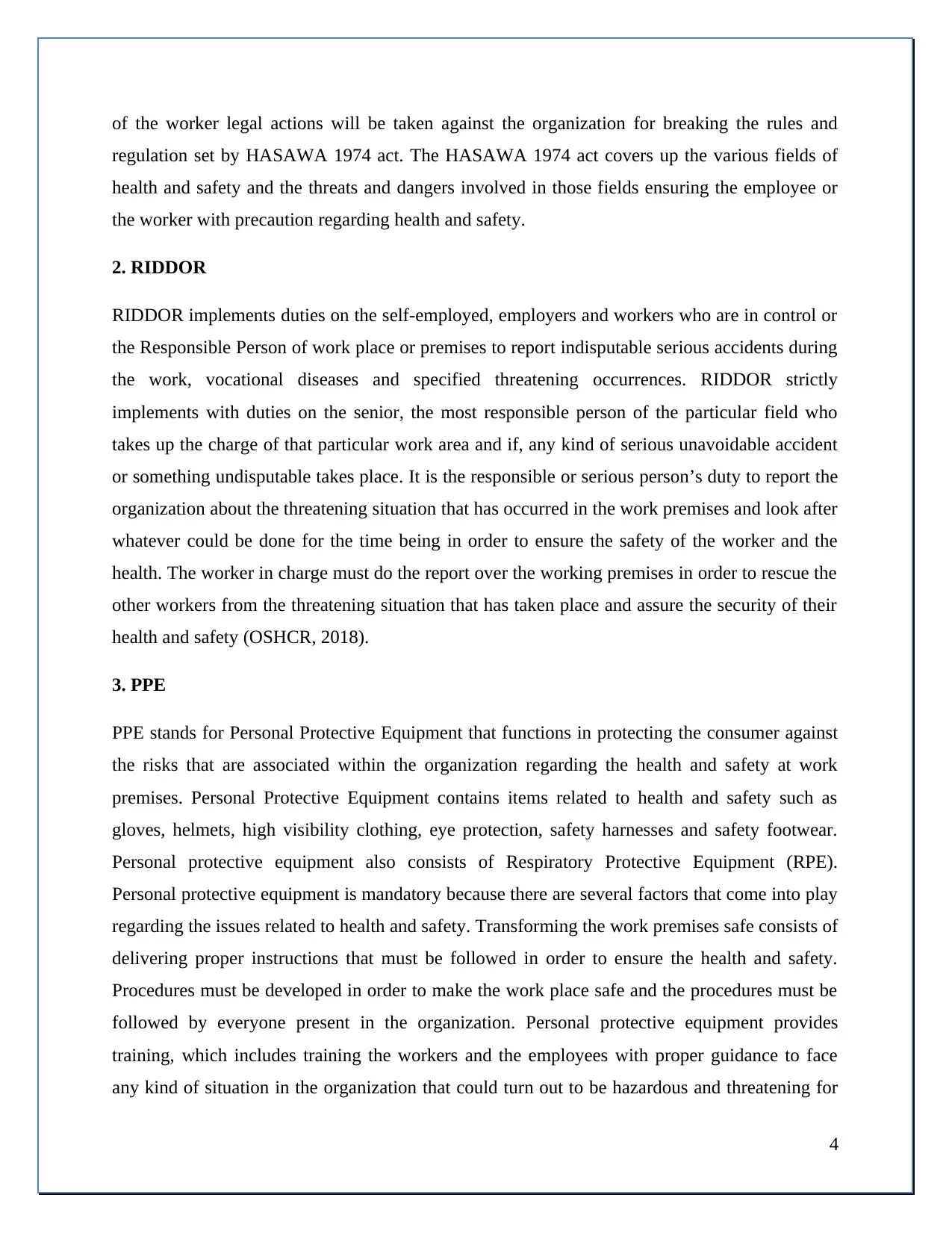
of the worker legal actions will be taken against the organization for breaking the rules and
regulation set by HASAWA 1974 act. The HASAWA 1974 act covers up the various fields of
health and safety and the threats and dangers involved in those fields ensuring the employee or
the worker with precaution regarding health and safety.
2. RIDDOR
RIDDOR implements duties on the self-employed, employers and workers who are in control or
the Responsible Person of work place or premises to report indisputable serious accidents during
the work, vocational diseases and specified threatening occurrences. RIDDOR strictly
implements with duties on the senior, the most responsible person of the particular field who
takes up the charge of that particular work area and if, any kind of serious unavoidable accident
or something undisputable takes place. It is the responsible or serious person’s duty to report the
organization about the threatening situation that has occurred in the work premises and look after
whatever could be done for the time being in order to ensure the safety of the worker and the
health. The worker in charge must do the report over the working premises in order to rescue the
other workers from the threatening situation that has taken place and assure the security of their
health and safety (OSHCR, 2018).
3. PPE
PPE stands for Personal Protective Equipment that functions in protecting the consumer against
the risks that are associated within the organization regarding the health and safety at work
premises. Personal Protective Equipment contains items related to health and safety such as
gloves, helmets, high visibility clothing, eye protection, safety harnesses and safety footwear.
Personal protective equipment also consists of Respiratory Protective Equipment (RPE).
Personal protective equipment is mandatory because there are several factors that come into play
regarding the issues related to health and safety. Transforming the work premises safe consists of
delivering proper instructions that must be followed in order to ensure the health and safety.
Procedures must be developed in order to make the work place safe and the procedures must be
followed by everyone present in the organization. Personal protective equipment provides
training, which includes training the workers and the employees with proper guidance to face
any kind of situation in the organization that could turn out to be hazardous and threatening for
4
regulation set by HASAWA 1974 act. The HASAWA 1974 act covers up the various fields of
health and safety and the threats and dangers involved in those fields ensuring the employee or
the worker with precaution regarding health and safety.
2. RIDDOR
RIDDOR implements duties on the self-employed, employers and workers who are in control or
the Responsible Person of work place or premises to report indisputable serious accidents during
the work, vocational diseases and specified threatening occurrences. RIDDOR strictly
implements with duties on the senior, the most responsible person of the particular field who
takes up the charge of that particular work area and if, any kind of serious unavoidable accident
or something undisputable takes place. It is the responsible or serious person’s duty to report the
organization about the threatening situation that has occurred in the work premises and look after
whatever could be done for the time being in order to ensure the safety of the worker and the
health. The worker in charge must do the report over the working premises in order to rescue the
other workers from the threatening situation that has taken place and assure the security of their
health and safety (OSHCR, 2018).
3. PPE
PPE stands for Personal Protective Equipment that functions in protecting the consumer against
the risks that are associated within the organization regarding the health and safety at work
premises. Personal Protective Equipment contains items related to health and safety such as
gloves, helmets, high visibility clothing, eye protection, safety harnesses and safety footwear.
Personal protective equipment also consists of Respiratory Protective Equipment (RPE).
Personal protective equipment is mandatory because there are several factors that come into play
regarding the issues related to health and safety. Transforming the work premises safe consists of
delivering proper instructions that must be followed in order to ensure the health and safety.
Procedures must be developed in order to make the work place safe and the procedures must be
followed by everyone present in the organization. Personal protective equipment provides
training, which includes training the workers and the employees with proper guidance to face
any kind of situation in the organization that could turn out to be hazardous and threatening for
4
Paraphrase This Document
Need a fresh take? Get an instant paraphrase of this document with our AI Paraphraser
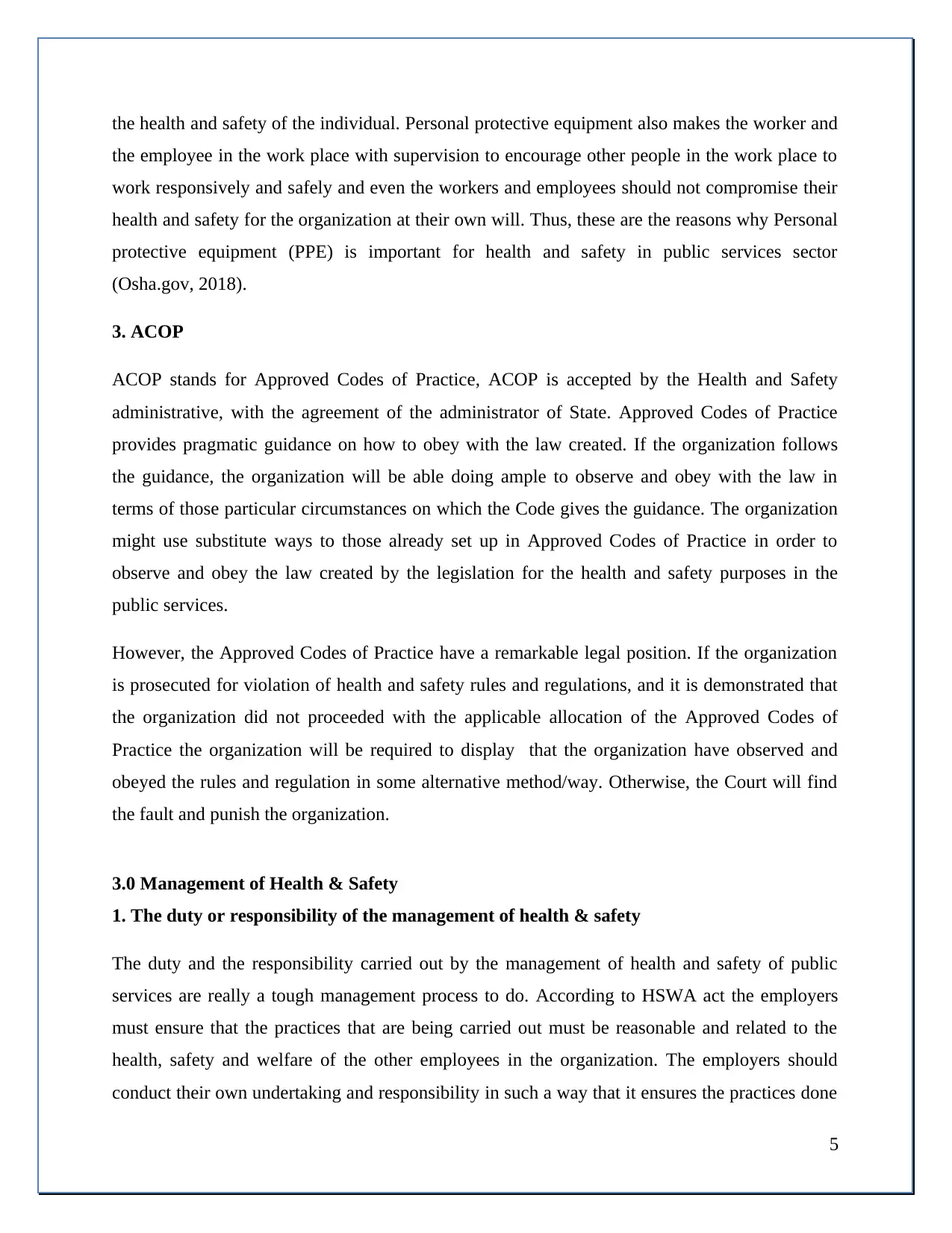
the health and safety of the individual. Personal protective equipment also makes the worker and
the employee in the work place with supervision to encourage other people in the work place to
work responsively and safely and even the workers and employees should not compromise their
health and safety for the organization at their own will. Thus, these are the reasons why Personal
protective equipment (PPE) is important for health and safety in public services sector
(Osha.gov, 2018).
3. ACOP
ACOP stands for Approved Codes of Practice, ACOP is accepted by the Health and Safety
administrative, with the agreement of the administrator of State. Approved Codes of Practice
provides pragmatic guidance on how to obey with the law created. If the organization follows
the guidance, the organization will be able doing ample to observe and obey with the law in
terms of those particular circumstances on which the Code gives the guidance. The organization
might use substitute ways to those already set up in Approved Codes of Practice in order to
observe and obey the law created by the legislation for the health and safety purposes in the
public services.
However, the Approved Codes of Practice have a remarkable legal position. If the organization
is prosecuted for violation of health and safety rules and regulations, and it is demonstrated that
the organization did not proceeded with the applicable allocation of the Approved Codes of
Practice the organization will be required to display that the organization have observed and
obeyed the rules and regulation in some alternative method/way. Otherwise, the Court will find
the fault and punish the organization.
3.0 Management of Health & Safety
1. The duty or responsibility of the management of health & safety
The duty and the responsibility carried out by the management of health and safety of public
services are really a tough management process to do. According to HSWA act the employers
must ensure that the practices that are being carried out must be reasonable and related to the
health, safety and welfare of the other employees in the organization. The employers should
conduct their own undertaking and responsibility in such a way that it ensures the practices done
5
the employee in the work place with supervision to encourage other people in the work place to
work responsively and safely and even the workers and employees should not compromise their
health and safety for the organization at their own will. Thus, these are the reasons why Personal
protective equipment (PPE) is important for health and safety in public services sector
(Osha.gov, 2018).
3. ACOP
ACOP stands for Approved Codes of Practice, ACOP is accepted by the Health and Safety
administrative, with the agreement of the administrator of State. Approved Codes of Practice
provides pragmatic guidance on how to obey with the law created. If the organization follows
the guidance, the organization will be able doing ample to observe and obey with the law in
terms of those particular circumstances on which the Code gives the guidance. The organization
might use substitute ways to those already set up in Approved Codes of Practice in order to
observe and obey the law created by the legislation for the health and safety purposes in the
public services.
However, the Approved Codes of Practice have a remarkable legal position. If the organization
is prosecuted for violation of health and safety rules and regulations, and it is demonstrated that
the organization did not proceeded with the applicable allocation of the Approved Codes of
Practice the organization will be required to display that the organization have observed and
obeyed the rules and regulation in some alternative method/way. Otherwise, the Court will find
the fault and punish the organization.
3.0 Management of Health & Safety
1. The duty or responsibility of the management of health & safety
The duty and the responsibility carried out by the management of health and safety of public
services are really a tough management process to do. According to HSWA act the employers
must ensure that the practices that are being carried out must be reasonable and related to the
health, safety and welfare of the other employees in the organization. The employers should
conduct their own undertaking and responsibility in such a way that it ensures the practices done
5
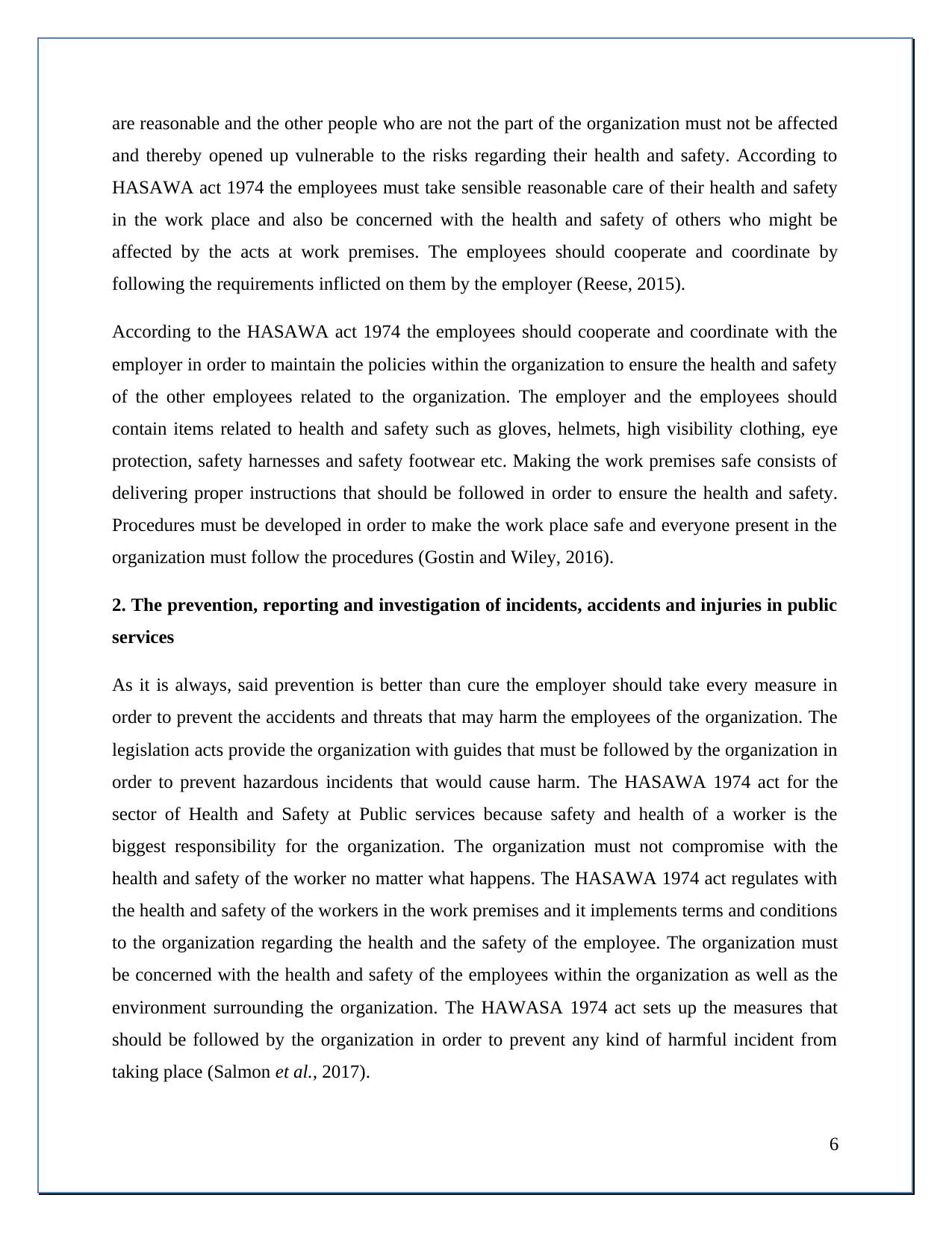
are reasonable and the other people who are not the part of the organization must not be affected
and thereby opened up vulnerable to the risks regarding their health and safety. According to
HASAWA act 1974 the employees must take sensible reasonable care of their health and safety
in the work place and also be concerned with the health and safety of others who might be
affected by the acts at work premises. The employees should cooperate and coordinate by
following the requirements inflicted on them by the employer (Reese, 2015).
According to the HASAWA act 1974 the employees should cooperate and coordinate with the
employer in order to maintain the policies within the organization to ensure the health and safety
of the other employees related to the organization. The employer and the employees should
contain items related to health and safety such as gloves, helmets, high visibility clothing, eye
protection, safety harnesses and safety footwear etc. Making the work premises safe consists of
delivering proper instructions that should be followed in order to ensure the health and safety.
Procedures must be developed in order to make the work place safe and everyone present in the
organization must follow the procedures (Gostin and Wiley, 2016).
2. The prevention, reporting and investigation of incidents, accidents and injuries in public
services
As it is always, said prevention is better than cure the employer should take every measure in
order to prevent the accidents and threats that may harm the employees of the organization. The
legislation acts provide the organization with guides that must be followed by the organization in
order to prevent hazardous incidents that would cause harm. The HASAWA 1974 act for the
sector of Health and Safety at Public services because safety and health of a worker is the
biggest responsibility for the organization. The organization must not compromise with the
health and safety of the worker no matter what happens. The HASAWA 1974 act regulates with
the health and safety of the workers in the work premises and it implements terms and conditions
to the organization regarding the health and the safety of the employee. The organization must
be concerned with the health and safety of the employees within the organization as well as the
environment surrounding the organization. The HAWASA 1974 act sets up the measures that
should be followed by the organization in order to prevent any kind of harmful incident from
taking place (Salmon et al., 2017).
6
and thereby opened up vulnerable to the risks regarding their health and safety. According to
HASAWA act 1974 the employees must take sensible reasonable care of their health and safety
in the work place and also be concerned with the health and safety of others who might be
affected by the acts at work premises. The employees should cooperate and coordinate by
following the requirements inflicted on them by the employer (Reese, 2015).
According to the HASAWA act 1974 the employees should cooperate and coordinate with the
employer in order to maintain the policies within the organization to ensure the health and safety
of the other employees related to the organization. The employer and the employees should
contain items related to health and safety such as gloves, helmets, high visibility clothing, eye
protection, safety harnesses and safety footwear etc. Making the work premises safe consists of
delivering proper instructions that should be followed in order to ensure the health and safety.
Procedures must be developed in order to make the work place safe and everyone present in the
organization must follow the procedures (Gostin and Wiley, 2016).
2. The prevention, reporting and investigation of incidents, accidents and injuries in public
services
As it is always, said prevention is better than cure the employer should take every measure in
order to prevent the accidents and threats that may harm the employees of the organization. The
legislation acts provide the organization with guides that must be followed by the organization in
order to prevent hazardous incidents that would cause harm. The HASAWA 1974 act for the
sector of Health and Safety at Public services because safety and health of a worker is the
biggest responsibility for the organization. The organization must not compromise with the
health and safety of the worker no matter what happens. The HASAWA 1974 act regulates with
the health and safety of the workers in the work premises and it implements terms and conditions
to the organization regarding the health and the safety of the employee. The organization must
be concerned with the health and safety of the employees within the organization as well as the
environment surrounding the organization. The HAWASA 1974 act sets up the measures that
should be followed by the organization in order to prevent any kind of harmful incident from
taking place (Salmon et al., 2017).
6
⊘ This is a preview!⊘
Do you want full access?
Subscribe today to unlock all pages.

Trusted by 1+ million students worldwide
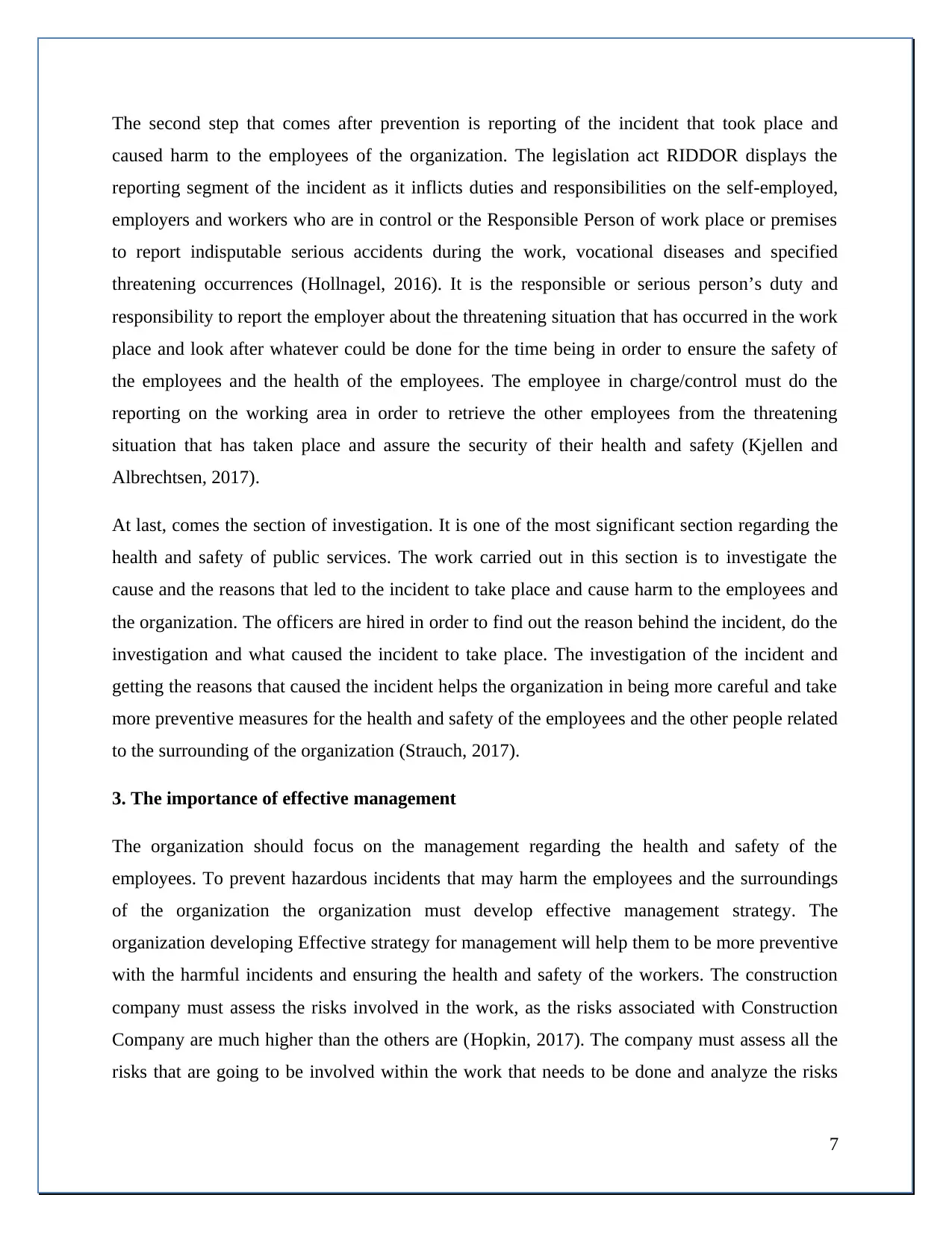
The second step that comes after prevention is reporting of the incident that took place and
caused harm to the employees of the organization. The legislation act RIDDOR displays the
reporting segment of the incident as it inflicts duties and responsibilities on the self-employed,
employers and workers who are in control or the Responsible Person of work place or premises
to report indisputable serious accidents during the work, vocational diseases and specified
threatening occurrences (Hollnagel, 2016). It is the responsible or serious person’s duty and
responsibility to report the employer about the threatening situation that has occurred in the work
place and look after whatever could be done for the time being in order to ensure the safety of
the employees and the health of the employees. The employee in charge/control must do the
reporting on the working area in order to retrieve the other employees from the threatening
situation that has taken place and assure the security of their health and safety (Kjellen and
Albrechtsen, 2017).
At last, comes the section of investigation. It is one of the most significant section regarding the
health and safety of public services. The work carried out in this section is to investigate the
cause and the reasons that led to the incident to take place and cause harm to the employees and
the organization. The officers are hired in order to find out the reason behind the incident, do the
investigation and what caused the incident to take place. The investigation of the incident and
getting the reasons that caused the incident helps the organization in being more careful and take
more preventive measures for the health and safety of the employees and the other people related
to the surrounding of the organization (Strauch, 2017).
3. The importance of effective management
The organization should focus on the management regarding the health and safety of the
employees. To prevent hazardous incidents that may harm the employees and the surroundings
of the organization the organization must develop effective management strategy. The
organization developing Effective strategy for management will help them to be more preventive
with the harmful incidents and ensuring the health and safety of the workers. The construction
company must assess the risks involved in the work, as the risks associated with Construction
Company are much higher than the others are (Hopkin, 2017). The company must assess all the
risks that are going to be involved within the work that needs to be done and analyze the risks
7
caused harm to the employees of the organization. The legislation act RIDDOR displays the
reporting segment of the incident as it inflicts duties and responsibilities on the self-employed,
employers and workers who are in control or the Responsible Person of work place or premises
to report indisputable serious accidents during the work, vocational diseases and specified
threatening occurrences (Hollnagel, 2016). It is the responsible or serious person’s duty and
responsibility to report the employer about the threatening situation that has occurred in the work
place and look after whatever could be done for the time being in order to ensure the safety of
the employees and the health of the employees. The employee in charge/control must do the
reporting on the working area in order to retrieve the other employees from the threatening
situation that has taken place and assure the security of their health and safety (Kjellen and
Albrechtsen, 2017).
At last, comes the section of investigation. It is one of the most significant section regarding the
health and safety of public services. The work carried out in this section is to investigate the
cause and the reasons that led to the incident to take place and cause harm to the employees and
the organization. The officers are hired in order to find out the reason behind the incident, do the
investigation and what caused the incident to take place. The investigation of the incident and
getting the reasons that caused the incident helps the organization in being more careful and take
more preventive measures for the health and safety of the employees and the other people related
to the surrounding of the organization (Strauch, 2017).
3. The importance of effective management
The organization should focus on the management regarding the health and safety of the
employees. To prevent hazardous incidents that may harm the employees and the surroundings
of the organization the organization must develop effective management strategy. The
organization developing Effective strategy for management will help them to be more preventive
with the harmful incidents and ensuring the health and safety of the workers. The construction
company must assess the risks involved in the work, as the risks associated with Construction
Company are much higher than the others are (Hopkin, 2017). The company must assess all the
risks that are going to be involved within the work that needs to be done and analyze the risks
7
Paraphrase This Document
Need a fresh take? Get an instant paraphrase of this document with our AI Paraphraser
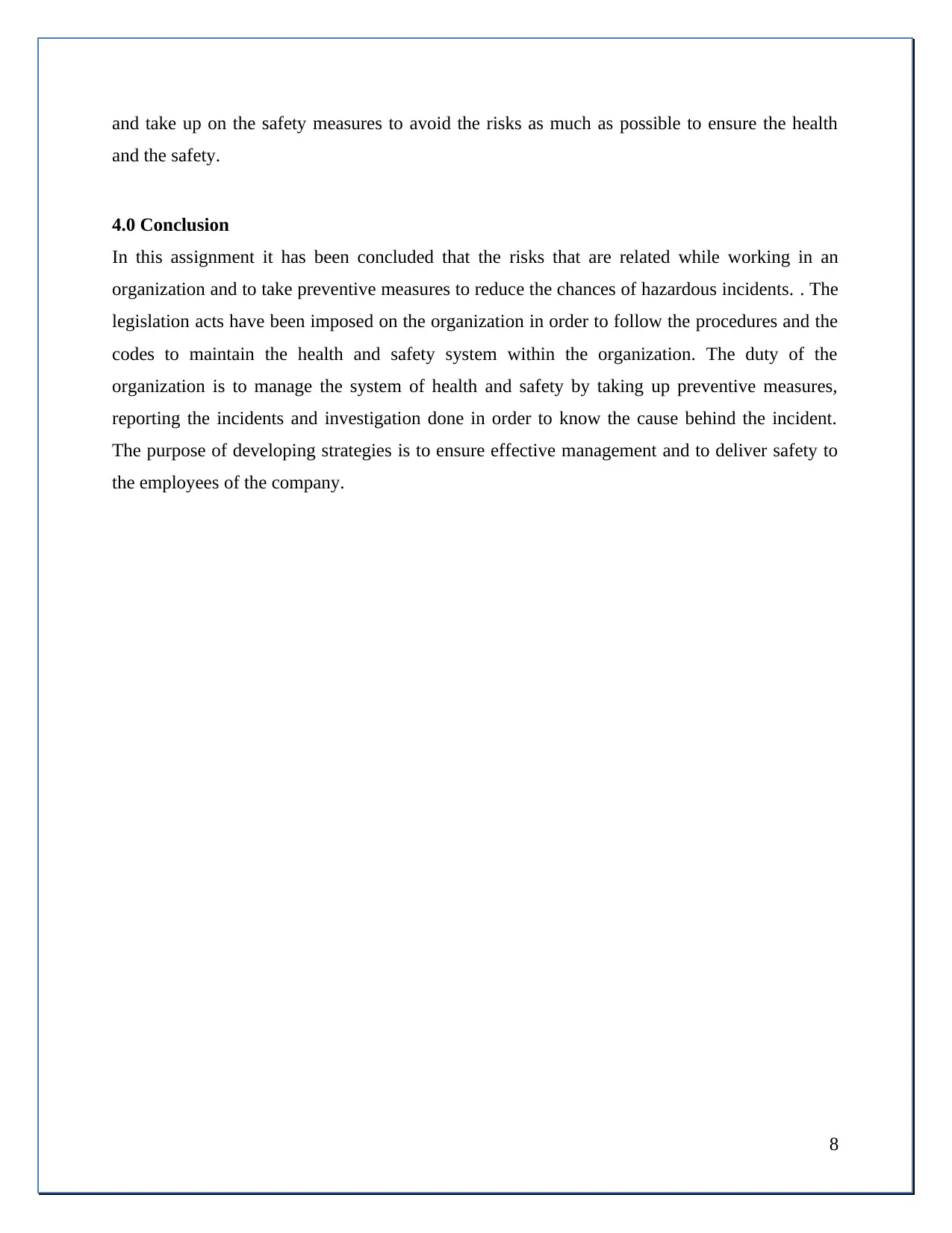
and take up on the safety measures to avoid the risks as much as possible to ensure the health
and the safety.
4.0 Conclusion
In this assignment it has been concluded that the risks that are related while working in an
organization and to take preventive measures to reduce the chances of hazardous incidents. . The
legislation acts have been imposed on the organization in order to follow the procedures and the
codes to maintain the health and safety system within the organization. The duty of the
organization is to manage the system of health and safety by taking up preventive measures,
reporting the incidents and investigation done in order to know the cause behind the incident.
The purpose of developing strategies is to ensure effective management and to deliver safety to
the employees of the company.
8
and the safety.
4.0 Conclusion
In this assignment it has been concluded that the risks that are related while working in an
organization and to take preventive measures to reduce the chances of hazardous incidents. . The
legislation acts have been imposed on the organization in order to follow the procedures and the
codes to maintain the health and safety system within the organization. The duty of the
organization is to manage the system of health and safety by taking up preventive measures,
reporting the incidents and investigation done in order to know the cause behind the incident.
The purpose of developing strategies is to ensure effective management and to deliver safety to
the employees of the company.
8
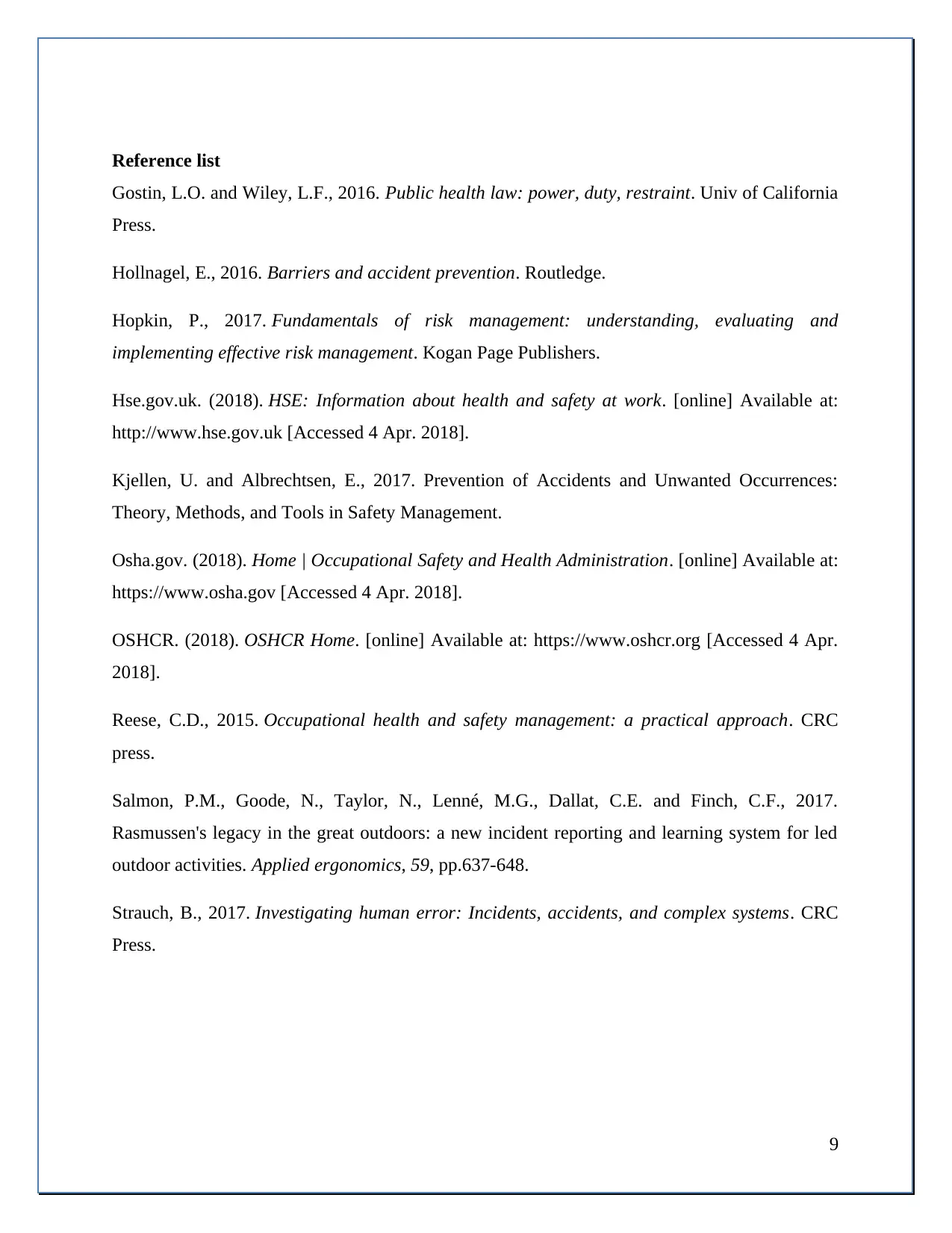
Reference list
Gostin, L.O. and Wiley, L.F., 2016. Public health law: power, duty, restraint. Univ of California
Press.
Hollnagel, E., 2016. Barriers and accident prevention. Routledge.
Hopkin, P., 2017. Fundamentals of risk management: understanding, evaluating and
implementing effective risk management. Kogan Page Publishers.
Hse.gov.uk. (2018). HSE: Information about health and safety at work. [online] Available at:
http://www.hse.gov.uk [Accessed 4 Apr. 2018].
Kjellen, U. and Albrechtsen, E., 2017. Prevention of Accidents and Unwanted Occurrences:
Theory, Methods, and Tools in Safety Management.
Osha.gov. (2018). Home | Occupational Safety and Health Administration. [online] Available at:
https://www.osha.gov [Accessed 4 Apr. 2018].
OSHCR. (2018). OSHCR Home. [online] Available at: https://www.oshcr.org [Accessed 4 Apr.
2018].
Reese, C.D., 2015. Occupational health and safety management: a practical approach. CRC
press.
Salmon, P.M., Goode, N., Taylor, N., Lenné, M.G., Dallat, C.E. and Finch, C.F., 2017.
Rasmussen's legacy in the great outdoors: a new incident reporting and learning system for led
outdoor activities. Applied ergonomics, 59, pp.637-648.
Strauch, B., 2017. Investigating human error: Incidents, accidents, and complex systems. CRC
Press.
9
Gostin, L.O. and Wiley, L.F., 2016. Public health law: power, duty, restraint. Univ of California
Press.
Hollnagel, E., 2016. Barriers and accident prevention. Routledge.
Hopkin, P., 2017. Fundamentals of risk management: understanding, evaluating and
implementing effective risk management. Kogan Page Publishers.
Hse.gov.uk. (2018). HSE: Information about health and safety at work. [online] Available at:
http://www.hse.gov.uk [Accessed 4 Apr. 2018].
Kjellen, U. and Albrechtsen, E., 2017. Prevention of Accidents and Unwanted Occurrences:
Theory, Methods, and Tools in Safety Management.
Osha.gov. (2018). Home | Occupational Safety and Health Administration. [online] Available at:
https://www.osha.gov [Accessed 4 Apr. 2018].
OSHCR. (2018). OSHCR Home. [online] Available at: https://www.oshcr.org [Accessed 4 Apr.
2018].
Reese, C.D., 2015. Occupational health and safety management: a practical approach. CRC
press.
Salmon, P.M., Goode, N., Taylor, N., Lenné, M.G., Dallat, C.E. and Finch, C.F., 2017.
Rasmussen's legacy in the great outdoors: a new incident reporting and learning system for led
outdoor activities. Applied ergonomics, 59, pp.637-648.
Strauch, B., 2017. Investigating human error: Incidents, accidents, and complex systems. CRC
Press.
9
⊘ This is a preview!⊘
Do you want full access?
Subscribe today to unlock all pages.

Trusted by 1+ million students worldwide
1 out of 9
Related Documents
Your All-in-One AI-Powered Toolkit for Academic Success.
+13062052269
info@desklib.com
Available 24*7 on WhatsApp / Email
![[object Object]](/_next/static/media/star-bottom.7253800d.svg)
Unlock your academic potential
Copyright © 2020–2025 A2Z Services. All Rights Reserved. Developed and managed by ZUCOL.





